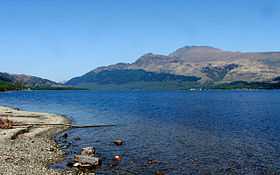National Trust for Scotland
 | |
| Motto | A place for everyone |
|---|---|
| Formation | 1931 |
| Legal status | Trust |
| Headquarters | Edinburgh, Scotland, United Kingdom |
| Location |
|
Official language | English |
| Website | http://www.nts.org.uk |

The National Trust for Scotland for Places of Historic Interest or Natural Beauty, commonly known as the National Trust for Scotland (Scottish Gaelic: Urras Nàiseanta na h-Alba) describes itself as "the conservation charity that protects and promotes Scotland's natural and cultural heritage for present and future generations to enjoy."[1]
History
The Trust was established in 1931 and (as of 2010) had 450 employees, over 310,000 members, and 1.5 million recorded visitors. It is similar in function to the National Trust, which covers England, Wales, and Northern Ireland, and to other national trusts worldwide.[2] The Trust's Patron is Prince Charles, Duke of Rothesay; the President is James Lindesay-Bethune, 16th Earl of Lindsay, and the Chairman is Sir Kenneth Calman.[3] It is a registered charity under Scottish law.[4]
The Trust owns and manages around 130 properties and 180,000 acres (730 km2) of land, including castles, ancient small dwellings, historic sites, gardens, and remote rural areas. Most grounds and open spaces are open throughout the year but buildings may generally only be visited from Easter to October, sometimes only in the afternoons.
Originally, the charity owned properties rather than "wilderness" areas. When the Trust took on the management of rural estates there was controversy concerning issues such as the siting of visitor centres and placing of signposts. However, the Trust has learned to adopt a more sensitive approach, even to the extent of removing some intrusive facilities such as the original Glen Coe Visitor Centre.
In August 2010, a report called Fit For Purpose[5] by George Reid, commissioned by the Trust, cited shortcomings that were corrected though organizational restructuring largely completed by the end of its 2011/12 Fiscal Year.[6]
Membership
Annual membership of the Trust allows free entry to properties and "Discovery Tickets" are available for shorter term visitors. Membership also provides free entry to National Trust properties in England and Wales and Northern Ireland, and vice versa. The Trust has independent sister organizations in the United States (The National Trust for Scotland Foundation USA), and Canada (The Canadian National Trust for Scotland Foundation). The organisation's membership magazine,Scotland in Trust, is published three times a year.
For the maintenance of its nature properties, the Trust depends on the contributions of volunteers, with local circles of Conservation Volunteers working on projects during weekends. The charity also organises working holidays called "Thistle Camps" on various properties, with activities undertaken including footpath maintenance and woodland work such as rhododendron control.
See also

References
- ↑ "About the Trust". National Trust for Scotland. Retrieved 17 March 2013.
- ↑ "Reciprocal entry sites". National Trust for Scotland. Retrieved 17 March 2013.
- ↑ "Change of chairman for conservation charity". National Trust for Scotland. 28 January 2010. Retrieved 17 March 2013.
- ↑ National Trust for Scotland, Registered Charity no. SC007410 at the Office of the Scottish Charity Regulator
- ↑ "A future for our past". National Trust for Scotland. Retrieved 17 March 2013.
- ↑ Severin Carrell (9 August 2010). "Scotland National Trust properties up for sale after review prompts reforms". The Guardian. Retrieved 17 March 2013.
Further reading
- Bremner, Douglas. For the Benefit of the Nation. McGraw-Hill Contemporary. 2001. ISBN 978-0-901625-69-4
External links
- The National Trust for Scotland
- The National Trust for Scotland Thistle Camps
- The National Trust for Scotland Foundation USA
- Scotland in Trust Magazine
| ||||||||||